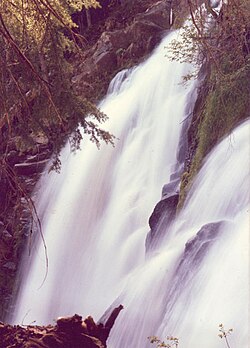Difference between revisions of "AY Honors/Waterfalls/Answer Key"
| Line 27: | Line 27: | ||
sam likes daniels hair | sam likes daniels hair | ||
| + | |||
| + | so do i | ||
==External links== | ==External links== | ||
Revision as of 04:54, 15 May 2006
A waterfall is usually a geological formation resulting from water, often in the form of a stream, flowing over an erosion-resistant rock formation that forms a sudden break in elevation. Waterfalls may also be artificial, and they are sometimes created as garden and landscape ornament.
Some waterfalls form in mountain environments where erosion is rapid and stream courses may be subject to sudden and catastrophic change. In such cases, the waterfall may not be the end product of many years of water action over a region, but rather the result of relatively sudden geological processes such as thrust faults or volcanic action.
Formation
Typically, a stream flow across an area of formations strata will form shelves across the streamway, elevated above the further stream bed when the less erosion-resistant rock around it disappears. Over a period of years, the edges of this shelf will gradually break away and the waterfall will steadily move upstream. Often, the rock strata just below the more resistant shelf will be of a softer type, and will erode out to form a shallow cave-like formation known as a rock shelter (also known as a rock house) under and behind the waterfall.
Waterfalls can also form due to glaciation, whereby a stream or river flowing into a glacier continues to flow into a valley after the glacier has receded or melted. The large waterfalls in Yosemite Valley are examples of this phenomenon.
Streams often become wider and more shallow just above waterfalls due to flowing over the rock shelf, and there is usually a deep pool just below the waterfall due to the kinetic energy of the water hitting the bottom.
Types of waterfalls
- Block
- Waterends a series of rock steps.
- Cataract
- A large waterfall. See Cataracts of the Nile for a well-known sequence of six.
- Fan
- Water spreads horizontally as it descends while remaining in contact with bedrock.
- Horsetail
- Descending water maintains some contact with bedrock.
- Plunge
- Water descends vertically, losing contact with the bedrock surface.
- Punchbowl
- Water descends in a constricted form, then spreads out in a wider pool.
- Segmented
- Distinctly separate flows of water form as it descends.
- Tiered
- Water drops in a series of distinct steps or falls.
- Multi step
- A series of waterfalls one after another of roughly the same size each with its own sunken plunge pool.
'Bold text'
sam likes daniels hair
so do i
External links
- World Waterfall Database
- WorldWaterfalls.com - Stock Waterfall Photos, Waterfall Information, Waterfall Forum
- Niagara Falls - Fullscreen QTVR Panorama
- Waterfalls of Victoria (Australia)
- Waterfalls of the world, links
ca:Cascada cs:Vodopád da:Vandfald de:Wasserfall et:Juga es:Cascada eo:Akvofalo fr:Chute d'eau gu:ધોધ id:Air terjun it:Cascata he:מפל מים la:Cataracta nl:Waterval ja:滝 no:Foss nn:Foss pl:Wodospad pt:Cachoeira simple:Waterfall sl:Slap su:Curug fi:Vesiputous sv:Vattenfall vi:Thác nước uk:Водоспад zh:瀑布



